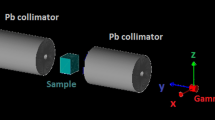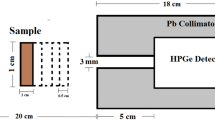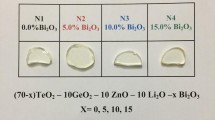Abstract
In this research, the radiation protection features of bismuth boro-tellurite doped with NdCl3 glass system in the form of 65B2O3–12.5Bi2O3–12.5TeO2–(10 − y)Na2O–yNdCl3 with \(0\leq y\leq10\) \({\text{mol}}\%\) have been investigated by using Phy-X/PSD, XMuDat and XCOM programs. The photon radiation shielding parameters of suggested glasses were calculated in the photon energy range of 0.015–15 MeV. The results showed that the addition of NdCl3 in the present glass system improves the shielding performance of the glasses system. The obtained results have been plotted and discussed in terms of photon energy. Also, the obtained results were compared together.















Similar content being viewed by others
References
IAEA, Harmony-the future of electricity. IAEA Bull. 25, 24–25 (2017)
A. Aşkın, M.I. Sayyed, A. Sharma, M. Dal, R. El-Mallawany, M.R. Kaçal, J. Non-Cryst. Solids 521, 119489 (2019)
A. Askin, Ceram. Int. 46(7), 9096 (2020)
Y. Al-Hadeethi, M.I. Sayyed, Ceram. Int. 46(2), 6136 (2020)
I.I. Guseinov, F. Oner, B.A. Mamedov, Prog. Nucl. Energy 48, 680 (2006)
I. Akkurt, K. El-Khayatt, J. Radioanal. Nucl. Chem. 295, 633 (2013)
Y. Al-Hadeethi, M.I. Sayyed, O. Ager, J. Non-Cryst. Solids 538, 120044 (2020)
J. Li, M. Huang, R. Hou, X. Ouyang, Radiat. Phys. Chem. 161, 23 (2019)
M. Caglar, H. Kayacik, Y. Karabul, M. Kilic, Z.G. Ozdemir, Prog. Nucl. Energy 117, 103119 (2019)
J. Singh, H. Singh, J. Sharma, T. Singh, P.S. Singh, Prog. Nucl. Energy 106, 387 (2018)
M.S. Al-Buriahi, Y.S. Rammah, Appl. Phys. A 125, 717 (2019)
T. Hasegawa, J. Non-Cryst. Solids 357, 2857 (2011)
S.A.M. Issa, A.M.A. Mostafa, M. Dong, V.P. Singh, H.O. Tekin, Radiat. Effect. Defect. Solids (2018). https://doi.org/10.1080/10420150.2018.1484743
V.P. Singh, N.M. Badiger, Radioprotection 48(3), 431 (2013)
M.E. Medhat, J. Radioanal. Nucl. Chem. 293, 55 (2012)
A. Saeed, R.M. El-Shazly, Y.H. El-bashar et al., Radiat. Phys. Chem. 102, 167 (2014)
K.J. Singh, S. Kaur, R.S. Kaundal, Radiat. Phys. Chem. 96, 153 (2014)
M.I. Sayyed, G. Lakshminarayana, M.G. Dong, M. Ersundu, A.E. Ersundu, I.V. Kityk, Radiat. Phys. Chem. 145, 26 (2018)
M.I. Sayyed, I.A. El-Mesady, A.S. Abouhaswa, A. Askin, Y.S. Rammah, J. Mol. Struct. 1197, 656 (2019)
M.S. Al-Buriahi, H. Arslan, B.T. Tonguç, Indian J. Pure Appl. Phys. 57(6), 433 (2019)
G. Lakshminarayana, I. Kebali, M.G. Dong, M.S. Al-Buriahi, I. Kebali, M.G. Dong, M.S. Al-Buriahi, A. Dahshan, I.V. Kityk, D.-E. Lee, J. Yoon, T. Park, J. Mater. Sci. 55, 5750 (2020)
P. Yasaka, N. Pattnaboonmee, H.J. Kim, P. Limkitjaroenporn, J. Kaewkhao, Ann. Nucl. Energy 68, 4 (2014)
S. Kaewjaeng, U. Maghanemi, S. Kothan, H.J. Kim, P. Limkitjaroenporn, J. Kaewkhao, Nucl. Eng. Des. 280, 21 (2014)
Y.S. Rammah, A.A. Ali, R. El-Mallawany, A.M. Abdelghany, J. Mol. Struct. (2018). https://doi.org/10.1016/j.molstruc.2018.07.071
T. Sato, Y. Okamoto, T. Ogawa, J. Nucl. Sci. Technol. 39, 635–637 (2002)
M. Elgazery, A.A. Ali, R. El-Mallawany, Egypt. J. Chem. 62(4), 655–664 (2019)
D.K. Gaikwad, M.I. Sayyed, S.N. Botewad et al., J. Non-Cryst. Solids 503, 158 (2019)
M.I. Sayyed, K.M. Kaky, D.K. Gaikwad, O. Agar, U.P. Gawai, S.O. Baki, J. Non-Cryst. Solids 507, 30–37 (2019)
S.A. Issa, H.O. Tekin, T.T. Erguzel, G. Susoy, Appl. Phys. A 125(9), 640 (2019)
M.I. Sayyed, Y.S. Rammah, A.S. Abouhaswa, H.O. Tekin, B.O. Elbashir, Phys. B 548, 20 (2018)
M. Dogra, K.J. Singh, K. Kaur, V. Anand, P. Kaur, P. Singh, B.S. Bajwa, Radiat. Phys. Chem. 144, 171 (2018)
M.I. Sayyed, A.A. Ali, H.O. Tekin, Y.S. Rammah, Appl. Phys. A 125, 445 (2019)
Phy-X/PSD software; https://doi.org/10.1016/j.radphyschem.2019.108496.
R. Nowotny, XMuDat: Photon Attenuation Data on PC; International Atomic Energy Agency, Nuclear Data Services, Version 1.0.1 of August 1998; https://www-nds.iaea.org/reports/nds-195.htm.
L. Gerward, N. Guilbert, B. Jensen, H. Levring, Radiat. Phys. Chem. 71, 653 (2004)
A. Mansour, M.I. Sayyed, K.A. Mahmoud, E. Sakar, E.G. Kovaleva, J. Radiat. Res. Appl. Sci. 13(1), 94 (2020)
E. Sakar, Radiat. Phys. Chem. 172, 108778 (2020)
Y. Al-hadeethi, M.I. Sayyed, Ceram. Int. 46(4), 4795 (2020)
B. Arthur, J.K. Shultis, R.E. Faw, Principles of Radiation Shielding (Prentice-Hall, Englewood Cliffs, New Jersey, 1984)
I. Han, L.S. Demir, M. Ahin, Radiat. Phys. Chem. 78, 760 (2009)
U. Cevik, E. Bacaksız, N. Damla, A. Celik, Radiat. Meas. 43, 1437 (2008)
Y. Harima, Nucl. Sci. Eng. 83(2), 299 (1983)
D.F. Jackson, D.J. Hawkes, Phys. Rep. 70, 169 (1981)
J.T. Bushberg, J.A. Seibert, M.E. Leidholdt, J.M. Boone, The Essential Physical of Medical Imaging, 2nd edn. (Lippincott Williams and Wilkins, Philadelphia, 2002)
V.P. Singh, N.M. Badiger, Ann. Nucl. Energy 64, 301 (2014)
M.G. Dong, X.X. Xue, Y. Elmahroug, M.I. Sayyed, M.H.M. Zaid, Results Phys. 14, 102129 (2019)
J. Wood, Computational Methods in Reactor Shielding (Pergamon Press Inc, New York, 1982)
I. Han, L. Demir, Nucl. Instrum. Methods Phys. Res. B 267, 3 (2009)
F. Akman, R. Durak, M.F. Turhan, M.R. Kacal, Appl. Radiat. Isot. 101, 107 (2015)
F. Akman, M.R. Kacal, M.S. Soylu, Can. J. Phys. 95, 1005 (2017)
H.C. Manjunatha, Radiat. Phys. Chem. 137, 254 (2017)
V.P. Singh, M.E. Medhat, N.M. Badiger, Nucl. Eng. Des. 270, 90 (2014)
V.P. Singh, N.M. Badiger, N. Chanthima, J. Kaewkhao, Radiat. Phys. Chem. 98, 14 (2014)
Author information
Authors and Affiliations
Corresponding author
Ethics declarations
Conflict of interest
There is no conflict to declare.
Additional information
Publisher's Note
Springer Nature remains neutral with regard to jurisdictional claims in published maps and institutional affiliations.
Appendices
Appendix
Theoretical background
Here, for the reader's convenience, the usual related formulae, basic shielding parameters, for \(\upgamma\)-ray shielding parameters are deduced as following equations.
In narrow-beam absorption experiments without any scattering effects, the intensity of the incident photons (\({I}_{0}\)) decreases depending on material thickness (t) and density (\(\rho ;\,{\text{g cm}}^{{ - 3}}\)). According to Beer–Lambert law, the linear attenuation coefficient (LAC), \(\mu\), is the parameter that explains the capability of the material to resist the incident \(\gamma\)-ray. It can be written for gamma photons that pass from a glass sample from the basic expression as below:
where \(t\left( {{\text{cm}}} \right)\) is the glass thickness, \(\left(I/{I}_{0}\right)\) the ratio is called the transmission factor in Eq. (1).
The mass attenuation coefficient (MAC), \({\mu }_{m},\) is defines the possibility of a \(\gamma\)-ray interacting with the material. If we are dealing with much more compounds, then the amount of MAC of components and mixtures of more than one element can be simply acquired using mixture rule [43], Eq. (3), as below:
where \(\rho\) is the density of material, \({w}_{i}\) is the weight fraction of the ith constituent element or the ration of the ith element in the glass and \({\left(\mu /\rho \right)}_{i}\) is the mass attenuation coefficient of the ith element from NIST Standard Reference Database in Unite States. This parameter is a notable factor for determining other protecting parameters like an effective atomic number (\(Z_{{{\text{eff}}}}\)). Further, it is a significant tool applied to infer other photon interaction parameters such as Half-value layer (HVL), Mean free path (MFP) etc.
For protecting materials, HVL and TVL are the necessary thickness to diminish the radiation intensities by one half and one-tenth, respectively. Indeed, one of the most outstanding parameters for portraying the effectiveness of gamma-ray shielding is HVL. In other words, HVL is the thickness of the material that decreases the photon beam intensity to 50% of its initial value (\({I}_{0}\)). However, the LAC is used to calculate these parameters as below:
And furthermore, the tenth value layer (TVL) is obtained as the thickness of absorber or radiation protecting that required to lessen the radiation intensity/incident radiation by a factor of 10. Therefore, the relation of TVL to LAC (\(\mu\)) defined by following equation [44]
Finally, MFP is a significant quantity that shortly and straightly shows the ability of any barrier investigated to decrease radiation to a more allowable level. Also, MFP is the thickness of the protecting materials for two consecutive collisions. In other words, it signifies the distance that the photons can travel through the medium between two collisions. Further, it is a term that explains the average distance between two interactions of photons and, as well-known, low MFP values correspond to effective shielding absorber. Then, as mathematically it can be assessed from linear attenuation coefficient, μ, and is expressed as follows [45]:
The total photon molecular cross-section \({\sigma }_{t}\) of the sample is given with the help of the mass attenuation coefficient according to the next equation [46]:
where \(M\) is the molecular weight of the sample, \({N}_{A}\) is the Avogadro's number, \({n}_{i}\) indicates the fractional abundance of the element i and \({A}_{i}\) is the atomic weight of ith element.
The average atomic cross-section or effective cross-section, \({\sigma }_{a}\), of the sample has been obtained by using Eq. (6) as below [46]:
The total electronic cross-section, \({\sigma }_{e}\), of the sample is given as follows [47, 48]:
where and \({Z}_{i}\) the atomic number of the constituent element.
In 1952, Hine first characterized the parameter \(( Z_{{{\text{eff}}}} )\) and he recommended that a single number cannot uniquely show the atomic number \((Z)\) within the varied energy regions for composite materials (such as a glass sample). For composite materials, this number is known as the effective atomic number and it varies with the photon energy value. Actually, the effective atomic number is critical for predicting how photons interact with a substance, as particular types of photon interactions depend on the atomic number.
For our glass systems, the following relation is applied to judge \(Z_{{{\text{eff}}}}\) [49, 50]:
The \(N_{{{\text{eff}}}}\) of samples can be obtained as below [48]:
where \(N_{A} = 6.022 \times 10^{{23}} /{\text{mol}}\).
The effective conductivity \(\left( {C_{{{\text{eff}}}} ;S/m} \right)\) of the materials is proportional to the \(N_{{{\text{eff}}}}\) and density of material and is shown by following equation [51]:
where \(e=1.6\times {10}^{-31} C\), \(h = 6.62 \times 10^{{ - 34}} \,{\text{m}}^{2} \,{\text{kgs}}^{{ - 1}}\), \(m_{e} = 9.11 \times 10^{{ - 31}} {\text{kg}}\), and \(k_{{\text{B}}} = 1.38 \times 10^{{ - 23}} \,{\text{m}}^{2} \,{\text{kgs}}^{{ - 2}} \,{\text{K}}^{{ - 1}}\) are the some physical constant and T is the temperature of the environment where the measurement is made.
The equal atomic number, \(Z_{{{\text{eq}}}}\), is an energy-dependent parameter, namely, it depends on the \({\mu }_{m}\) results from the Compton interactions and total \({\mu }_{m}\) of the glass as shown in next Eq. (13) as below [42]:
The following formula was applied to interpolate the \(Z_{{{\text{eq}}}}\) as below [52]:
where \({Z}_{1}\) and \({Z}_{2}\) are the elements atomic numbers identical to the ratios \({R}_{1}\) and \({R}_{2}\), respectively. Here, R is the ratio incoherent Compton scattering to the mass attenuation coefficient of the glass samples at a special energy.
The five various G-P fitting parameters for the glass samples have been logarithmically interpolated utilizing the same equation as follows [52, 53]:
where C shows the fitting parameters (a, b, c, d and XK) of investigated material into next equations, the two constants \({C}_{1}\) and \({C}_{2}\) are corresponding to \({Z}_{1}\) and \({Z}_{2}\), respectively. Now, we can calculate the fitting of G-P parameters to compute the EBF of glass samples from equations as follows:
where b is the value of the buildup factor at 1 mfp and \(K\left(E,X\right)\) is obtained as below:
where E is the photon energy incident/primary on the material and \(X\) is the penetration depth in \({\text{mfp}}\), on the other hand, X refers to distance between the detector and the radioactive source in unit of \({\text{mfp}}\). The variance of parameter \(K\left(E,X\right)\) with \(X\), gives the photon dose multiplicative factor and assign the shape of the spectrum.
Rights and permissions
About this article
Cite this article
Eshghi, M. Investigation of radiation protection features of the TeO2–B2O3–Bi2O3–Na2O–NdCl3 glass systems. J Mater Sci: Mater Electron 31, 16479–16497 (2020). https://doi.org/10.1007/s10854-020-04202-z
Received:
Accepted:
Published:
Issue Date:
DOI: https://doi.org/10.1007/s10854-020-04202-z




